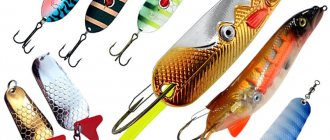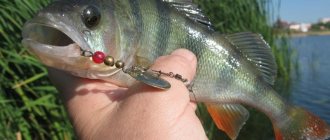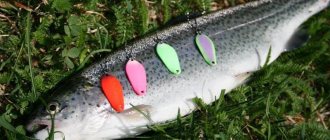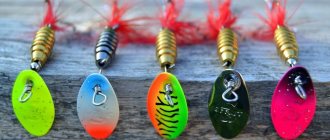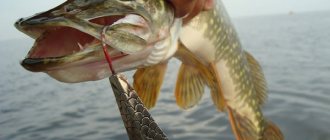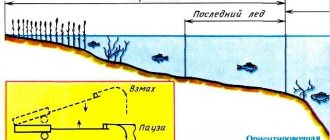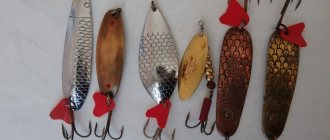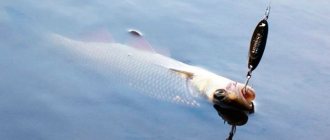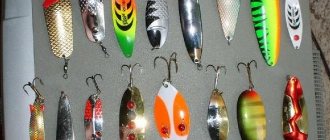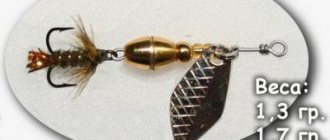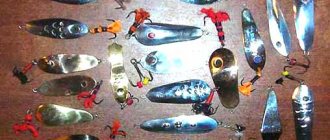Often when fishing there are conditions in which the weight of a spinning bait plays a key role. Often the own weight of an artificial fish is insufficient. This situation occurs when you need to cast to a remote catching point, or when making a retrieve in a fast current, or if it is important to quickly deliver the spinner to the lower horizons of the reservoir. Knowing how to weight a lure will help in any of these cases and will make fishing more interesting and its results positive.
Which lures should be weighted?
When talking about weighting, it should immediately be noted that such manipulations should only be performed with rotating spoons. The fact is that adding weighting changes to the spoon will greatly change its game, which can negatively affect the performance of the spoon. The result of the modification in this case will also affect the spinner’s overall catch.
By the way! Sometimes you can observe the opposite effect: as soon as you drop a little tin on a non-working vibrator, it will sparkle with new colors and become attractive to a predator!
Weighting the turntable will not affect its performance, since it does not affect the main working element - the petal. Here you only need to increase the weight of the core.
Attention! To replace the core, choose a weight with axial symmetry so that there is no displacement of the mass around the spinner rod.
Other weighting methods
In addition to making changes to the design of the bait, there are other ways to increase the weight of the equipment. For long casting, stability of the bait and its quick delivery to the desired horizon, the following is used:
1. Equipping with a bombard - a special float with positive, neutral or negative buoyancy.
2. One of the spaced jig rigs:
- splitshot,
- diverter leash,
- Texas,
- Carolina
Which option to choose depends on the fishing conditions and the angler’s preferences. “American” rigs work better in grass, and Moscow rigs in snags.
By the way, you can also use oscillating spoons with bombards and jigs; equipping them with an external load will not affect their performance.
If you simply put additional weight in front of the spoon, like using a jig “Cheburashka” with an offset hook, the position of the center of gravity of the equipment will change, which is fraught not only with a malfunction of the bait, but also with the leash tangling behind the rear tee when casting.
What to look for when using a spinner
When using and purchasing turntables, you should pay attention to the following characteristics:
- Color.
- Size.
- Loading.
- Rotation angle.
- Petal shape.
- Weight.
Color
By its nature, perch is not very picky about the colors of baits, so you can safely use classic colors for it: silver, red, gold and copper tints, bright colors.
As practice shows, perch reacts most to baits that have at least a small particle of red color. This could be a red petal or any other red spots that could catch the fish's eyes.
Size
When choosing the size of a spoon, you should know that the larger it is, the larger the fish it will catch, so the fisherman must first determine what kind of fish he will “hunt” and, based on this, buy a spoon. The classic size of “pinwheels” is considered to be from four to seven centimeters.
Loading
A standard “spinner” consists of a small cone-shaped weight, a ball and an additional weight for casting distance. The cone and ball function to provide free rotation of the petal. The petal itself is attached to a small bow.
The weight does not allow the spoon to dangle much in the water, so it can more smoothly and orderly perform its main task - to attract fish. In addition, spinners can be rear-loaded or front-loaded.
Rotation angle
The angle of rotation can be determined “by eye” by looking at the shape of the petal.
The petal, which has a narrow and oblong shape, has a rotation angle of about thirty degrees, therefore, due to the fact that it has low resistance, it can be used in large currents.
Spoonbaits whose petals are oval in shape usually have a rotation angle of fifty degrees. They are able to attract fish from very long distances, since they create certain sound waves with their structure.
Petal shape
The shape of the petals of spinners is:
- Round. Used in reservoirs with weak currents.
- Narrow and long. They are very effective when fishing in large currents.
- Oval and elongated. Can be used in almost all fishing conditions.
- The petal is without a clamp, which is simply attached to the base of the spoon.
Weight
It is best to use spinners of medium weight - from five to ten grams. Lighter spoons will be subject to current all the time, while heavier ones, on the contrary, will rotate poorly.
Weighting order
In order to make a spinner heavier, you need to replace the standard core with a weight made of heavy metal: lead or tungsten. Ready-made fishing elements with ready-made holes will help us with this, such as:
- sliding weights;
- winter jigs.
In the first case, we will simply replace the standard core with a sliding weight. In the second, we remove the hook from the jig and put the ball on the axis of the bait.
There are several other ways to increase the weight of the spinner. In the first case, a lead plate or wire can be used as a weighting agent, which is glued to the core. The load of the bait will also increase if you clamp an ordinary lead pellet of the required size on the tee of the turntable.
If during fishing you experience inconvenience when working with light bait, and you don’t have a heavier spoon with you, you should try to increase the weight of the existing one. To do this, you can use standard sinkers or jigs, and work with ordinary pliers.
Preparing to assemble the turntable
Some of the details - small petals and arches - can be made by hand. This is even necessary, taking into account their use in conjunction with “flies” tied on single hooks and, of course, the fact that petals smaller than No. 00 are not yet available for sale in our country.
Wire frame of turntable
The main role in the “spinner” is played by its playing element – the petal. It is this that attracts fish while the bait is in action and arouses in it a hunting reflex, curiosity or aggression.
About incompatible
Assembling the turntable
The front part of all baits is almost the same. This is one or two (which is stronger, but more noticeable) turns of the wire around the very end of the half of the working part of the mini-round pliers (the perforation is performed with this very tool). Moreover, it is more convenient to twist “towards yourself”, firmly holding the wire with a tool and intercepting it as a tight ring forms.
Two turns are also necessary when using less visible thin wire. When the fishing line is tied directly to the bait, and intermediate links - a carabiner, a swivel and a leash - are excluded. In order to achieve simplicity and delicacy of gear.
A more conventional design of the front part is also possible. In it, after creating the traditional front ring, the wire is not bitten off and a weight is put on it. After which the wire is bent and only then bitten off.
The difference lies only in the size and, therefore, in the mass of tungsten balls (former jigs, if necessary, annealed over an open flame to give them inconspicuousness), which, after creating the rings, are put on the ends of the wire facing downwards. After which they bend in the direction opposite to the movement of the bait (with their hands, holding the ball with pliers), and bite off short with wire cutters.
The ball bearings (two or one) necessary to create rotation of the petal, located immediately behind the bow, rest on the pin clasp. Why is it performed flat, directed perpendicular to the axis of rotation of the petal. In mini spinners, the ball rests on beads, which in turn are adjacent to the back of the bait, where the hook is located. And this part can be done in different ways.
The ring is needed only because the size of the mini-baits does not allow them to be framed with 0.6 mm wire in the form of a pin. But there is another wire. In addition, to replace the “flies” you can use a regular winding ring, even if it is just one more detail.
In general, we all know how difficult it is to cast a “spinner” that has a petal the size of a little fingernail and is equipped with a sailing “fly”. And we understand how difficult it is to load it, making the line non-twisting and compact. Which, however, is possible with the help of these structures.
Practical tips
It seems that crystal clear instructions have not yet been achieved. I would like to think that it is only because of the ambiguity of those things and phenomena that we encounter while fishing. But let's try to get down to practice.
And you must remember that when testing and fine-tuning the petal (in a basin or bath), you should get approximately the same angle and speed of rotation in both directions relative to the direction of movement of the bait.
Finally, I would like to say that in the field of symbiosis of “flies” and mini-petals, one should not rely only on spinning canons. And that this is a vast field of activity, where the labor expended is more than compensated by the pleasure of the results.
It looks like the instructions really didn't work out. Rather, I again suggested a “line of thought.” I hope that you will find it interesting - and I can only wish you success, which you will certainly receive if you devote attention, energy and time to it.
Andrew Vladimirovich
Welcome to our forum! You are logged in as a guest and can read the forum. To send messages you need to log in with your login or register.
(Login | Registration)
Andrey
Profile Group: Users Messages: 277 Registration: 13.6.2013 From: Finland User No.: 1439 Name: Andrei Fishing gear: spinning, fishing rod, fly fishing, donka. Metro/Area:Kotka
Andrey
Profile Group: Users Messages: 277 Registration: 13.6.2013 From: Finland User No.: 1439 Name: Andrei Fishing gear: spinning, fishing rod, fly fishing, donka. Metro/Area:Kotka
Mihaylov
Profile Group: Users Messages: 1066 Registration: 4/30/2013 User No.: 1237 Name: Oleg Fishing gear: spinning
Andrey
Profile Group: Users Messages: 277 Registration: 13.6.2013 From: Finland User No.: 1439 Name: Andrei Fishing gear: spinning, fishing rod, fly fishing, donka. Metro/Area:Kotka
Mihaylov
Profile Group: Users Messages: 1066 Registration: 4/30/2013 User No.: 1237 Name: Oleg Fishing gear: spinning
Andrey
Profile Group: Users Messages: 277 Registration: 13.6.2013 From: Finland User No.: 1439 Name: Andrei Fishing gear: spinning, fishing rod, fly fishing, donka. Metro/Area:Kotka
the spinner itself is as light as a ferret, but if you can stand in the same place in the headwind and you need to throw it 70 meters away, then I’m trying to experiment
Tips for fisherman: Winter fishing rod for trolling with your own hands - What is the difference, pros and cons
Mihaylov
Profile Group: Users Messages: 1066 Registration: 4/30/2013 User No.: 1237 Name: Oleg Fishing gear: spinning
blesnyuk
Profile Group: Blocked Messages: 9770 Registration: 14.3.2012 From: . User No: 466 Name. Fishing gear. Metro/District.
“Love your land. You didn't inherit it from your parents. She was borrowed by you from your children."
Andrey
Profile Group: Users Messages: 277 Registration: 13.6.2013 From: Finland User No.: 1439 Name: Andrei Fishing gear: spinning, fishing rod, fly fishing, donka. Metro/Area:Kotka
I’ll try this too, what is the length of the leash? and what kind of wiring should it be? i.e. how to guide it at all or just lift it up a little with the flow?
salmon962
Profile Group: Blocked Messages: 5425 Registration: 7/31/2012 User No.: 646 Name: Alexey Fishing gear: fly fishing and other methods Metro/District: center
This is normal, working equipment! By the way, it is better to use an eccentric weight as an anti-twist. sometimes, if not too lazy, I used a weight with a hook, because... a certain number of attacks fall into it. Fish often loves tandems!
The turntables do not need to oscillate to the side, the load will not spoil their play!
blesnyuk
Profile Group: Blocked Messages: 9770 Registration: 14.3.2012 From: . User No: 466 Name. Fishing gear. Metro/District.
I think around a meter. Wiring is best in an arc for demolition. The weight of the load must be selected for this.
This is normal, working equipment! By the way, it is better to use an eccentric weight as an anti-twist. sometimes, if not too lazy, I used a weight with a hook, because... a certain number of attacks fall into it. Fish often loves tandems!
The turntables do not need to oscillate to the side, the load will not spoil their play!
Lyosha, but Andrey wrote “60 grams of weight.” A bit much.
“Love your land. You didn't inherit it from your parents. She was borrowed by you from your children."
Andrey
Profile Group: Users Messages: 277 Registration: 13.6.2013 From: Finland User No.: 1439 Name: Andrei Fishing gear: spinning, fishing rod, fly fishing, donka. Metro/Area:Kotka
SERZHIK
Profile Group: Users Messages: 256 Registration: 5/19/2013 User No.: 1317 Name: xxxx Fishing gear: no information for the CROWD
Andrey
Profile Group: Users Messages: 277 Registration: 13.6.2013 From: Finland User No.: 1439 Name: Andrei Fishing gear: spinning, fishing rod, fly fishing, donka. Metro/Area:Kotka
blesnyuk
Profile Group: Blocked Messages: 9770 Registration: 14.3.2012 From: . User No: 466 Name. Fishing gear. Metro/District.
Now it’s clear why you can’t throw a light spinner! Well, where does 0.4 go? This is to be treasured only.
“Love your land. You didn't inherit it from your parents. She was borrowed by you from your children."
Andrey
Profile Group: Users Messages: 277 Registration: 13.6.2013 From: Finland User No.: 1439 Name: Andrei Fishing gear: spinning, fishing rod, fly fishing, donka. Metro/Area:Kotka
Andrew Vladimirovich
Profile Group: Users Messages: 161 Registration: 7/27/2013 From: North-West User No.: 1706 Name: Andrey Fishing gear: spinning, donka, fishing rod Metro/District: Nevsky
Dear, please advise on this issue. Some Savage spinners, for example, or Pontoon in size 2, describe a circle (or vibrate) in the area of the ring, i.e. at first. The petal is spinning. I hook it through the tee. Cord 0.12. What is this for? Can we bend it somehow?
Slava 63
Attachments
Kostya is small
Mortalus
Dear, please advise on this issue. Some Savage spinners, for example, or Pontoon in size 2, describe a circle (or vibrate) in the area of the ring, i.e. at first. The petal is spinning. I hook it through the tee. Cord 0.12. What is this for? Can we bend it somehow?
Slava 63
Dear, please advise on this issue. Some Savage spinners, for example, or Pontoon in size 2, describe a circle (or vibrate) in the area of the ring, i.e. at first. The petal is spinning. I hook it through the tee. Cord 0.12. What is this for? Can we bend it somehow?
Mortalus
That’s a shame, I wanted to write about the clasp with a swivel, but at that moment I was thinking about the tee
Swivel clasp of course. Here's a spinner, God knows, it looks smooth to me. What might you see?
not a friend
Blocked
That’s a shame, I wanted to write about the clasp with a swivel, but at that moment I was thinking about the tee
Swivel clasp of course. Here's a spinner, God knows, it looks smooth to me. What might you see? View attachment 5478266 View attachment 5478268
Slava 63
That’s a shame, I wanted to write about the clasp with a swivel, but at that moment I was thinking about the tee
Swivel clasp of course. Here's a spinner, God knows, it looks smooth to me. What might you see? View attachment 5478266 View attachment 5478268
In the top photo (No. 1) it seems to be clear that the visible part of the wire on which the petal is attached is not on the same axis with the core, although I could be wrong due to the shooting angle
———- Message added at 16:46 ———- Previous message posted at 16:41 ———-
1. Having their own game. 2. Not having their own game.
Long cast. "Flying" spinners. Review.
The next day, a trip to the store, buying a long-range fishing rod, the necessary braid. In general, the whole week passed in creative torment and now the long-awaited weekend. I wasn't driving, I was flying to my favorite place. The picture is the same. Densely trampled snow, fishermen, in general, complete pressure. I put a bait, cast another, and now the first pike perch is already on the shore. The fishing went well.
But I still couldn’t catch a lot of places, I missed them a little. It was then that the question arose about the technique of long-distance casting and about baits that allow this to be done. So, what are these super-long-range baits, what qualities should they have, what is their distinguishing feature? I will try to talk about my observations using specific examples.
To begin with, let's try to divide jigs into two types:
1. With a shifted center of gravity. 2. With the center of gravity in the center.
Lures with a shifted center of gravity are slightly volatile and, most importantly, resist cross winds very well. What is this connected with? Everything is very simple - the weighted tail part of the bait pulls the other half and the cord along with it. When there is a gust of wind, this order does not change. An analogy can be drawn with a front-wheel drive car. When the car is in tension, it is more resistant to adverse situations, ice, dirt, etc.
How to cast these baits correctly? I do it like this. Release the bait no more than 40 cm from the tulip. Move the rod forward and bend it slightly to the side. Make a swing and, without stopping, send the bait sharply in the desired direction. With this casting technique, the throwing energy of the spinner is maximum. And it’s quite possible to throw away the treasured cell phone. This throw can be compared to the blow of a whip. But there is one “but” - if the reel’s cam is prone to self-closing, then you can’t avoid numerous shootings.
Tips for fisherman: Do-it-yourself fishing rod for trolling perch - Answers for beginners
Next, consider the following type of bait. These are baits with a center of gravity in the middle. I also want to divide them into two subtypes:
1. Having their own game. 2. Not having their own game.
Let's consider the first subtype of bait with its own game. The Cast Master also belongs to this subspecies. The wiring of these baits is much more varied than jigs with a shifted center of gravity. You can do regular wiring, stepwise, with pauses, without pauses. In any case, this type of spinner will exhibit certain movements reminiscent of the play of a fry. There are no specific recommendations on which wiring to choose. You need to experiment until you get the desired result.
Lures that do not have their own game are best fished using the same technique as jigs with a shifted center of gravity. They need to be “thrown up” and all possible animations must be done at the moment of falling.
What does this type of bait have in common? They are to varying degrees sensitive to wind and the slightest sticking of the cord. If you carefully look at the flight of these baits, you will see the following: 50% of the flight usually goes well, and then some kind of distortion occurs. Either the wind, or sticking or something else, and the spinner begins to dangle in flight. Its speed is quickly lost and the desired cast is only in the project. How to deal with this?
With a wide cast-master, you can drill a hole in the top of the spoon. To avoid turbulence during wiring, close this hole with a bead or fill it with something light. For example, epoxy. The center of gravity of the spinner will shift to the tee and you will get a spinner with a displaced center of gravity. But for narrow spinners this is unacceptable; therefore, poor flight performance can only be combated using casting techniques. These spinners need to be accelerated and that’s what I do.
I release the spinner 1.5 m from the tulip. I hold the spinning rod behind my head and make a slight tilt. And with acceleration in geometric progression, I send the spinner in the right direction. Directly at the moment of casting, you need to help a little with your shoulder. Thus, you will slightly increase the casting energy. In case of emergency, such a cast can be done with a short run. This will add a few more precious meters to your piggy bank.
Now I will try to summarize everything that I said above. It is simply not practical to describe how each of these spinners works. This is a matter of personal feelings of the fisherman. There are no identical bodies of water, only similar ones. Each body of water has its own specifics, therefore the animation in the wiring is different everywhere.
This type of spinner can be used to catch almost any predatory fish. Armed with an arsenal of long-range baits, you will have a huge advantage over your colleagues. You will get fish where others cannot. And the consequences of everyday pressure will bother you much less. In this review I tried to talk about jigs and its varieties. But there are also wobblers, rubber, turntables, etc. So, to be continued.
Especially for www. fion. ru Dmitry Baryshev ( bd 256)
The main “face” of the turntable is the metal petal. It can be of different sizes and shapes. It is the petal that rotates on the bait, creating a vibration in the water that is attractive to predators.
